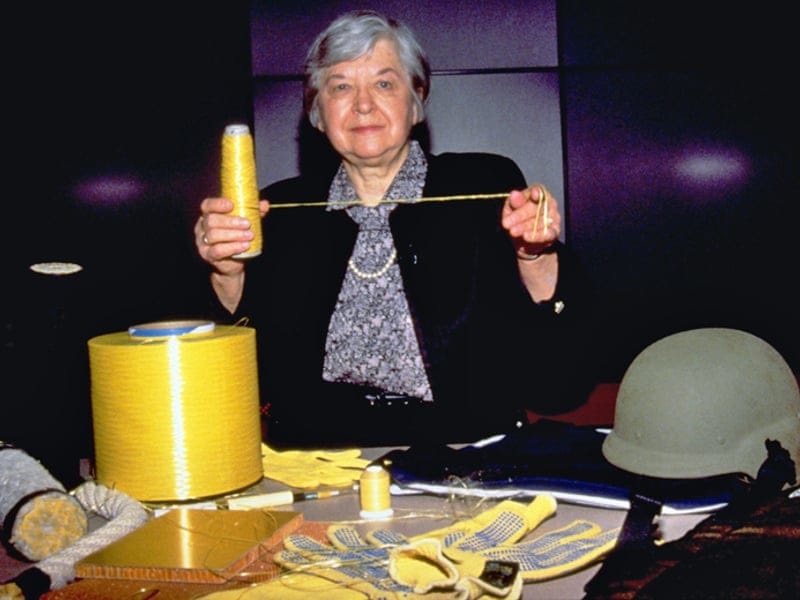When you google “how was Kevlar invented” the answer that immediately pops up is, “by accident.” This is true to a point, but the more complete answer is thanks to Stephanie Kwolek.
Read on for more in The Mag Life’s first article by Stephanie Martz.

“This is my first article writing for The Mag Life. I was given the idea by my editor. When first seeing the name I thought, “Wow, pretty standard, my first article and he gives me a female war story, typical man.”
How dare I even think that.
This woman, this Patriot, gave us an invention that will serve us for 40+ years and lead to future technology. My editor gave me a story about someone that did more for our country with an idea that a lot of us will ever do or even fathom. So, how dare I think just wow, another female war story.”
Stephanie Kwolek
Her name was found simply by researching the development of ballistic helmets. A standard search when it comes to the current gear veneration. A company that many know, Second Chance, sold their 1 millionth vest around the same time she passed, June 18th, 2014. An armor company founded in 1970, five years after a scientist by the name of Stephanie Kwolek discovered a crystalline solution that will lead to years of space exploration, ballistically improved equipment, and the ability to cross a river due to strong cables holding a bridge.
Her Background
Stephanie Kwolek was a scientist with many facets. Born in 1923 right outside of Pittsburgh, Stephanie grew up with two immigrant Polish parents. One a seamstress, and another a naturalist. This grew Kowlek’s interest in patterns and design yet also science. The Smithsonian Magazine talks of Stephanie’s walks in the woods noticing patterns in spiderwebs. She would then draw for hours these and other patterns to perfection.
After graduating from Carnegie College, Kwolek applied for a job with Dupont Chemical Company intending to be a doctor. While a scientist is about brains and detail, is it not about overall confidence? After her interview with Dupont she was told what we all hear, “you will hear from us in the coming weeks”. That wasn’t good enough for Kwolek. “With great boldness—I would never do it now—I said to him, ‘I wonder if you could possibly tell me sooner because there is another company that wants me to decide whether I should come and work for them.’” –Kwolek, smithsonianmag.

She was hired on the spot and worked for Dupont for 40 more years. In those 40 years after boldly showing her worth to her future boss, Kwolek went on to invent something instrumental to this country’s safety and strength…liquid rope.
“A lot of people owe her their lives and they don’t even know it”- David Reeder, TML Editor
Before Kevlar
Now before we go any further, let’s talk about what our now-Kevlar items were made from before Kwolek.
The M1917 derived from the British helmet, the Brodie helmet was basically a bowl made of metal, according to the Smithsonian. The inside had a basic liner against the Soldiers scalp, leather chin strap, and altogether weighed around 1.3 lbs. Compare that to a Kevlar helmet now, which depending on the cut and size, will be around 3 lbs.

It took 30 more years to evolve the making of the helmet. In 1941 the M1 helmet came to light and had a manganese steel outer shell. Which nowadays manganese steel is used in safes and anti drill plates. (Try wearing that on your head all day..oof.) The M1 helmet weighed closer to our current weight 2.88. It also featured an upgraded chin strap that broke away under pressure. Another fun fact, this was the first time that the web like liner had the ability to tighten and loosen, just like our adjustable webbing lined helmets today.
Steel Manganese still couldn’t stop closer range munitions but the science just simply wasn’t there yet and the M1 helmet stuck around until…you guessed it, 1965 when Kwolek gave us our liquid rope, or in much more tactically sound terms, the material for Kevlar and Yoga Pants.
The Process
With a possible oncoming fuel shortage a group of Scientists within DuPont Chemical Company were tasked with inventing lighter fibers for use in cars that would consume less gas. In the early 1960’s DuPont made an aramid fiber called and patented Nomex. This fiber is heavily resistant to electrical and chemical abrasion. As always though, DuPont continued into their discoveries of strong fibers.
During her work, Stephanie Kwolek would need to find a solvent that did not totally melt the polymers used to make the fiber, but instead dissolve the polymers into a liquid. She found it, which in turn lead to the greatest accident that will shape our modern battlefield.
When discovering the thick milky solution that led to the strong fibers Kwolek ran into an “oh no” moment. You know the moment where you are working in a class on something and it comes out to look 20 times different than the students next to you? You look around the room and think you must have done something wrong. Instead of Kwolek thinking she made a mistake due to her milky thick substance instead of others in her group that had a thin like clear substance she kept her confidence and kept working on it, not showing anyone
“I think someone who wasn’t thinking very much or just wasn’t aware or took less interest in it, would have thrown [the solution] out. The fibers created from this solution were the strongest anyone had ever seen—plastic strong enough to stop bullets and knives—described as being “five times stronger than steel on an equal weight basis.”– Kwolek, Edge of Yesterday.com
Within a lot of industries, even the firearms industry, the invention of an item often comes before the machines to properly reproduce or experiment on said item. When experimenting on liquids that are then turned into fibers they are spun by a machine called a “spinneret”. The spinneret is ultimately run by humans that egos can be sometimes too much for their own good.
As Kwolek remembers the moment she took her solution to the man running the spinneret, “he said to me, ‘this will never spin, it flows like water. And, furthermore, it has particles in it and these will plug up the holes of the spinneret.’ Well, previous to talking to him, I had filtered the solution….and there was no separation—the whole thing went through. I was convinced this solution would spin, because it just had the right flow and cohesive properties.” After several days arguing with the man, “I wore him down,” Kwolek laughs. “He said he would spin it. So we spun it and it spun beautifully,”.
In the end, Kwolek invented a new fiber called an “aramid fiber” and a new substance called “liquid crystalline solutions”.
After the Invention
The name Kevlar was then named and patented by the Dupont Chemical Company. Kwolek gave all rights to the Company. Shortly thereafter the Army began their research and development by the Army Natick Development Center out of Watertown Arsenal in Massachusetts. In 1983 the first Kevlar helmet was introduced within the Personnel Armor System for Ground Troops (PASGT). The PASGT also introduced a Kevlar Vest within the system.
Kevlar is still being used 40 years after that within our current Military armor systems. The Kevlar fiber laid groundwork to more recent fibers such as GENTEXComposite Materials, which just released a OpsCore helmet, Spectra Armor which provides armor for man, vehicle, and aircraft, and Carbon X, a material highly resistant to flame and electricity..sound familiar?
Stephanie Kwolek was named head of Polymer Research at DuPont’s Pioneering Lab until her retirement in 1986. She was awarded “Creative Invention” from ACS in 1980. In 1995 Kwolek was the fourth woman to be added to the National Inventors hall of Fame. In 97, she received the Perkin Medal from the American Chemical Society in 1997, and finally she was added to the National Women’s Hall of Fame in 2003.
Kwolek continued consulting for DuPont throughout her retirement and held many speaking engagements. In an interview with Kwolek she states that the reason she did not consult outside of DuPont even though many wanted to hire her is due to other companies only wanting to get as much information out of her about Kevlar as they could and she was not interested in providing that. Smart Woman. Instead she did lectures and worked within programs for young people in Science.
“I think you have to inspire young people to believe in themselves and not to fear thinking differently.”– Kwolek
Imagine if she didn’t push for that job. Imagine if she didn’t push the scientist working the spinneret to spin her solution. Imagine if she didn’t push her worth in this lifetime because of fear that her product looked different than others. We may not have the capabilities that we have now for another forty years, or three World Wars from now.
Yes, Kevlar was discovered by accident. But as Stephanie states, “With years you accumulate knowledge and with years you can do things that you could not do” With her hard work and years of gaining knowledge and pushing her career, she discovered a new Crystalline Solution that will lead to even more discovery and lives saved.
To students, Kwolek says,
“Every person has value, no matter what you do. This is what you have to remember.”
Her name was found all because someone was researching ballistic helmets.
Stephanie Louise Kwolek, Jul 31, 1923 – Jun 18, 2014 (age 90)
Rest in Peace ma’am, we are all indebted to you.

Properties Kevlar Below
KEVLAR
Kevlar is the more heat resistant of the two types of Aramid. It is also extremely high in strength—up to 22 gr/denier, which is 5X the strength of steel of the same diameter.
KEVLAR Properties:
| Strength: | up to 22 gr/denier
does not lose significant strength when wet or hot |
| Moisture Regain: | 3.4-7.0% |
| Elongation: | 4%, which is quite low, making it hard to spin into yarns. |
| Sun Resistance: | Mod |
| Acids/Alkali: | Resistant |
| Specific Gravity: | 1.44 gr/cc—relatively heavy, especially when used in a dense fabric as in bullet proof vests. |
| Thermal Properties: | carbonizes @ 900 F |
| Brands: | Kevlar (Dupont) & Twaron by Akzo Nobel (moisture regain 7.0)
Technora by Teijin LTD (moisture regain @ 2.0) |
bellevuecollege.edu/artshum/materials/indes/Paul/Fall04/SpclEndUseFibers.htm


